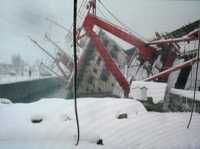
I'm not sure what the fascination with Tarkovsky is about. He's obtuse and totally non-commercial. You might even have to think about something to understand what is going on in his films. Continuing my fascination, the past week has been spent watching on several different occasions The Sacrifice. This was Tarkovsky's final film prior to his death from cancer in 1986. It was a co-production of the Swedish Film Institute and Film Four, photographed by Sven Nykvist, and stars Erland Josephson.
This is the third viewing for me. It's finally beginning to come into focus. The opening sequence, after the titles, is a single nine minute tracking shot with a mention of Nietzsche, the "rotation" of the cycle of life, hope, despair, death, another life's performance, no chance for an Absolute Truth. During this shot, and then slightly later, there is the not so distant sound of an explosion, or is it thunder. For the characters on screen, the sound barely registers. It is only later that they find out that war has broken out, and that their country probably faces annihilation.

Alexander, a journalist, actor, critic, and lapsed man of religious faith, collapses and prays to his God for the first time in years to save his family, and humanity. He wants to make a bargain that he will give up everything he has if God will stop the war and put everything back the way it was the day previous.
 By the end, when time has been turned back on itself, and the day of his birthday begins once again, Alexander goes mad at the possibility that he must uphold his end of the bargain. But we are left wondering if Maria the "witch", a pre Christian animus of power has been the cause of the reversal of destruction, or the God of organized religion has spared us one more time.
By the end, when time has been turned back on itself, and the day of his birthday begins once again, Alexander goes mad at the possibility that he must uphold his end of the bargain. But we are left wondering if Maria the "witch", a pre Christian animus of power has been the cause of the reversal of destruction, or the God of organized religion has spared us one more time.
Rather than these two incompatibles, the final image returns us to the opening location, the track beside the sea, with the spindley tree once again center frame. Only this time, Little Man has decided to take his father at his word and initiate a "system" that will change the world. He drags two buckets of water towards the tree, determined to start a daily watering ritual, much as the monk in Alexander's first story of the film did.
The Kino International DVD copy of the film is rather standard quality, hardly a signal to demonstrate the superior capabilities of the HD format. But as per usual, the sound can be dramatic, such as when jets fly closely over the house and it becomes obvious that the world is at war once again. At least the film is available to watch the mastery of Tarkovsky as captured by Nykvist - in the comfort of our own screening rooms.
Any other Tarkovsky fans out there with something to add?
 Thursday, August 30, 2012 at 05:00AM
Thursday, August 30, 2012 at 05:00AM  KMW |
KMW |  2 Comments |
2 Comments |  Roscoe,
Roscoe,  Steadicam,
Steadicam,  video,
video,  world cinema
world cinema 


















































